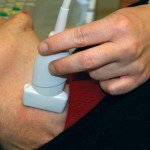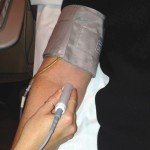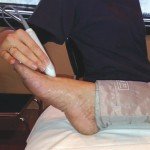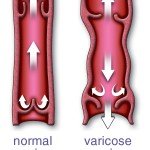What we look for when we screen a patient:
• Stroke – Plaque buildup in the carotid arteries of the neck
• AAA –An enlarged abdominal aorta (aneurysm)
• PVD –Abnormal ratio of blood pressures in arms and legs
• Venous Insufficiency (VI) –Reverse blood flow in the legs
What is a stroke?
A stroke is an interruption of blood flow to the brain

What we look for: Plaque buildup in the carotid arteries of the neck
What we use: Ultrasound probe
Stroke risk factors:
• Age – The lifetime risk of stroke over the age of 55 is greater than 1 in 6
• Gender – Men are more likely to have a stroke than women
• Family History – Your risk of a stroke is greater if your mother or father had a stroke
• Personal History – Your risk of a stroke is greater if you have already had a stroke
• Race – Your risk of dying from a stroke is greater if you are African-American
What is an abdominal aortic aneurysm?
An abdominal aortic aneurysm (AAA) occurs when there is a weak area in the aortic wall. This weakened area bulges and forms a sac-like balloon that, if left undiagnosed, may eventually rupture, causing severe hemorrhaging and possibly death.

What we look for: An enlarged abdominal aorta (aneurysm)
What we use: Ultrasound probe
AAA risk factors:
• Age – Your risk of AAA increases after the age of 60
• Gender – Men are 10 times more likely to have an AAA than women
• Family History – Your risk of AAA is greater if your mother or father had one
• Personal History – Your risk of AAA is greater if you have a history of heart disease or Peripheral Vascular Disease
• High blood pressure
• Smoking – Smokers are 8 times more likely to be affected by AAA than non-smokers
What is peripheral vascular disease (PVD)?


Peripheral vascular disease is diminished blood flow to the lower legs or feet caused by plaque buildup in the internal lining of an artery.
What we look for: Abnormal ratio of blood pressures in arms and legs
What we use: Blood pressure cuff at upper arms and ankles
What is venous insufficiency?
Venous insufficiency (also known as venous reflux) is a disease where one or more valves in the leg veins do not close properly. This leads to blood pooling in the legs, which causes pressure, swelling and varicose veins.
What we look for: Improper (reverse) blood flow in the groin area (upper leg check) and behind the knees (lower leg check).
What we use: Ultrasound probe
Venous insufficiency symptoms:
• One or more of the following in the legs: pain, heaviness, swelling, burning, itching, throbbing, tenderness
• Bleeding and/or sores in severe cases
Venous insufficiency risk factors:
• Heredity
• Gender – Women are more likely to get VI than men
• Lifestyle/Occupation – People who stand a lot or do a lot of heavy lifting are more at risk
• Pregnancies – Women who have had multiple pregnancies are more at risk
• Obesity – People who are obese are more at risk
All ultrasound exams are completed by registered vascular technologists (RVT) and interpreted by physicians.
We bill insurance and accept Medicare. We have contracted with most local insurance agencies to determine if we are a proffered provider. Please contact your insurance carrier with questions.
